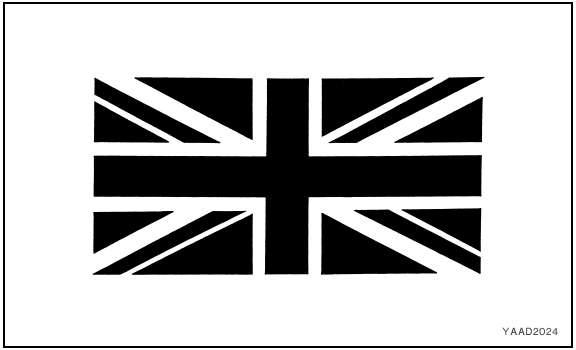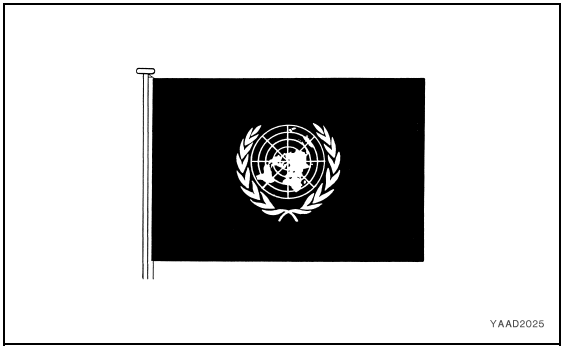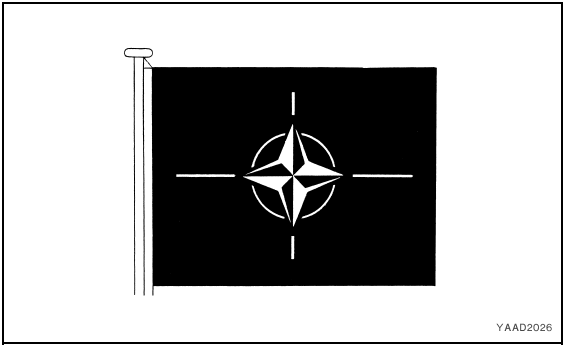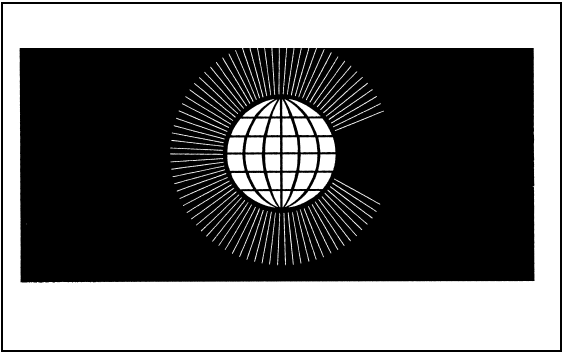Heritage Structure | Section 8 – Other Flags
Table of contents
- Section 8 – Other flags (4-8-1)
- Commonwealth and foreign flags (4-8-1)
- The Royal Union flag (4-8-1)
- International flags (4-8-2)
- Provincial and municipal flags (4-8-6)
COMMONWEALTH AND FOREIGN FLAGS
- Flags or ensigns of Commonwealth or foreign countries may be flown:
- when an official representative of the country visits a defence establishment or ship;
- on "official days" of the country at defence establishments outside Canada; and
- when an Her Majesty's Canadian (HMC) ship officially visits another country.
- A flag should never be used as drapery of any sort; never festooned; never drawn back, up, or in folds; but always allowed to fall free.
THE ROYAL UNION FLAG
- The Royal Union Flag, commonly known as the 'Union Jack' (Figure 4-8-1), was approved by Parliament on 18 December 1964 for continued use as a symbol of Canada's membership in the Commonwealth of Nations and of her allegiance to the Crown.
- The Royal Union Flag shall, where physical arrangements make it possible, be flown in addition to the National Flag, Canadian Forces (CF) Ensign, Ship's Ensign and Jack, and command flag, as appropriate, at defence establishments and in HMC ships within Canada or Canadian waters:
- on the date of the official observance of Her Majesty the Queen's Birthday (Victoria Day, the Monday preceding 25 May);
- on the anniversary of the adoption of the Statute of Westminster (11 December);
- on the date of the official observance of Commonwealth Day (the second Monday in March); and
- when instructed by National Defence Headquarters (NDHQ).
NOTES
- "Physical arrangements" means the existence of at least two flag poles. The National Flag will always take precedence and will not be replaced by the Royal Union Flag.
- The Royal Union Flag may be flown with the National Flag at appropriate federal locations in Canada in connection with ceremonies, marking anniversaries of events in which Canadian forces participated with other Commonwealth forces. In all cases prior permission must be sought from NDHQ.

Figure 4-8-1 The Royal Union Flag
INTERNATIONAL FLAGS
- United Nations Flag. The United Nations (UN) Flag (Figure 4-8-2) may:
- be used generally in UN-sponsored military operations, but only on expressed authorization by a competent UN authority;
- be flown outside by UN member countries on their own soil if a competent authority of the UN has expressly authorized its use (application to fly the UN Flag in Canada shall be made through the chain of command, stating the special reasons why this symbol of an international organization is appropriate for the circumstances – NDHQ/Director of History and Heritage will forward the application to the UN through the Department of Foreign Affairs); and
- be displayed indoors in Canada, without reference to NDHQ, to demonstrate support of the UN and to further its principles and purposes; however
- not be used to drape a casket within Canadian territory (see Section 2, paragraph 17).

Figure 4-8-2 The United Nations Flag
- NATO Flag. The NATO Flag (Figure 4-8-3) may:
- be used in military operations as a member country of NATO;
- be flown by NATO member countries on their own soil and on NATO bases in Europe; and
- be displayed indoors in Canada, without reference to NDHQ, to demonstrate support of NATO and to further its principles and purposes.

Figure 4-8-3 The NATO Flag
- The Red Cross (Red Crescent/Red Lion and Sun) Flag (see Figure 4-8-4):
- The Geneva Convention for the Amelioration of the Condition of the Wounded and Sick in the Armed Forces in the Field authorizes the flying of a white flag with a red cross as an international symbol of medical facilities. It may also be accompanied by the National Flag at medical unit fixed establishments. The Red Crescent and Red Lion and Sun are equivalent symbols for medical units of Muslim and Iranian armed forces.
- CF hospitals and medical installations established at fixed locations will fly both the National Flag and the Red Cross Flag. The Red Cross Flag will be flown vertically from a horizontal crosspiece (yard) or from a separate gaff so as to hang free, open and readily identifiable at all times, even in still air.

Figure 4-8-4 The Red Cross Flag
- The Commonwealth Flag. The Commonwealth Flag (Figure 4-8-5) may be flown at CF units when they are participating in a Commonwealth event or are assisting in the occurrence of this event.

Figure 4-8-5 The Commonwealth Flag
PROVINCIAL AND MUNICIPAL FLAGS
- Provincial flags are relatively recent in origin. They are emblems of the provinces and the people within them. At times they are used as miniature distinguishing flags by premiers and ministers representing the provincial government.
- Provincial flags give precedence to the National Flag and to Commonwealth and foreign national flags when official representatives are in attendance. Local or municipal flags give precedence to national and provincial flags.
- ChPrecedence among provincial flags is based on the dates of entering Confederation. The order is: Ontario (ON), Quebec (QC), Nova Scotia (NS), New Brunswick (NB), Manitoba (MB), British Columbia (BC), Prince Edward Island (PE), Saskatchewan (SK), Alberta (AB), Newfoundland and Labrador (NL); followed by North West Territories (NT), Yukon (YK) and Nunavut (NU).
- When the provincial flags are flown with the National Flag of Canada, the National Flag shall be on its own right, that is on the left of the line of flags as seen by a spectator from the front. The provincial flags continue down the line of flags in the order of precedence detailed in paragraph 11. An additional national flag may be displayed at the end of the line if desired.
- ChAn alternative method of display is with the National Flag in the centre. When this method of display is used, the National Flag is flown in the centre, while the provincial flag sequence alternates left and right (as seen by a spectator) from the inside outward, ie, the NU Flag is far left and the YK Flag is far right. Grouping is as follows:

Figure 4-8-6 Display Method – National Flag in the Centre
- In either display method, the size of the flags and the level at which they fly should be the same.
- Provincial flags shall only be flown on Department of National Defence (DND) property as a complete set of all provincial flags, and only for display purposes such as around a parade square.
- Municipal flags are not flown on DND property.